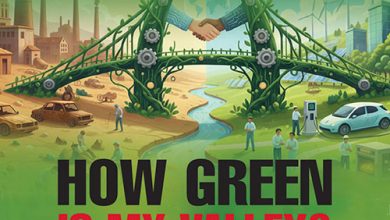CLIMATE CRISIS
A FORCE NOT TO BE IGNORED
Samantha Amerasinghe outlines the myriad economic impacts of climate change
Climate change is the defining challenge of our time. The scientific data suggests its effects are occurring at an unprecedented rate. More than half of total cumulative emissions since the Industrial Revolution were emitted in the past four decades.
Year 2019 was the second warmest on record with the global average temperature exceeding that of the preindustrial era by 1.1°C and each successive decade being warmer than any previous one since 1980. Climate change poses one of the greatest challenges to economic growth and development.
From a development perspective, economic growth and environmental sustainability are mutually reinforcing. There continue to be fears that the growth process entails greater use of natural resources and places increasing pressures on the natural environment.
The livelihoods of over half the economically active population in the developing world depend directly or indirectly on the environment through agriculture, animal husbandry, hunting, fisheries, forestry and foraging.
Rapid population growth places pressure on limited land, water and fuelwood shortages. This underscores the importance of environmental sustainability and why it has become increasingly important to the process of economic development.
Climate change is a major driver of environmental change and an inevitable force that can no longer be ignored. Over the last several decades, warmer temperatures caused by climate change have had the largest impact on the world’s poorest and most vulnerable people.
The interaction between poverty and environmental degradation can lead to a self-perpetuating process whereby communities inadvertently destroy the resources on which they depend for survival.
Growing consumption needs of people in less developed countries have led to the destruction of the world’s remaining forests, many of which are concentrated in highly indebted developing countries.
In many of the world’s developing countries, GDP per capita has been lower due to global warming over the past two decades. In Bangladesh and Sub-Saharan Africa in particular, climate change has impacted economic output through decreased labour productivity due to extreme heat, lower crop yields and declines in cognitive functioning.
There is a significant inequity between countries’ emissions and impacts – often, those who contribute to climate change the least suffer from it the most. Some regions could see growth decline by as much as six percent of GDP by 2050, according to a recent report by the World Bank.
Low income groups particularly in rural areas will be impacted the most by environmental degradation as it reinforces poverty. For instance, their capacity to earn or receive education could be affected by health problems related to pollution and food insecurity.
Most cumulative environmental destruction has been caused by the developed world but this pattern has reversed in recent years on account of high fertility rates, rising average incomes and increasing greenhouse gas emissions in these regions. China is the world’s largest greenhouse gas emitter but on a per capita basis, it remains lower than most developed countries.
The relationship between income inequality and the use of natural resources is complex. For much of the 20th century, income inequality between countries widened while income inequality within countries narrowed. But since 1980, both these trends have reversed. Greater income inequality generally creates upward pressure on resources, both through the impact of conspicuous consumption and the middle class squeeze.
The COP26 UN Climate Change Conference originally due to be held this November in Glasgow has been postponed until November 2021 in the light of COVID-19. It is set to be the first ‘global stocktake’ to assess progress on climate change as outlined in the Paris Agreement, which came into force on 4 November 2016.
In the agreement, all countries agreed to work to limit the global temperature rise to well below 2°C and given the dire risks, to strive for 1.5°C. According to the IPCC, the UN sponsored international scientific body analysing climate change and its impacts, to have a good chance of staying below 2°C and at manageable costs, emissions should drop by 40-70 percent globally between 2010 and 2050, falling to zero by 2100.
The Trump administration is expected to formally withdraw the US from the climate pact in November. However, presidential hopeful Joe Biden armed with a commanding lead in the polls ahead of November’s US presidential election – has said he would rejoin the Paris climate agreement, representing a fundamental reversal of Washington’s approach.
Biden promises an overhaul of America’s energy system that will put climate change at its heart. His plan earmarks US$ 2 trillion in spending over the next four years to use climate policy to drag the economy out of its pandemic era recession.
In the future, it is inevitable that the need for energy will continue to increase for two key reasons: to promote economic development in poor countries and help reduce the unsustainable consumption of material resources.
‘Grow now, clean up later’ has sadly been the business model for much of the world since the Industrial Revolution. Protecting the environment has often been perceived as an add-on when economies are doing well but otherwise deemed a needless distraction. To avoid catastrophic climate change and resource scarcity, a major shift towards affordable and sustainable energy resources is required.








